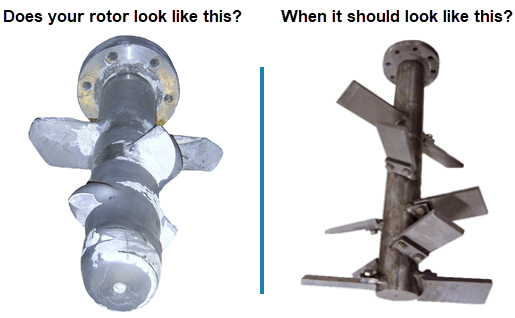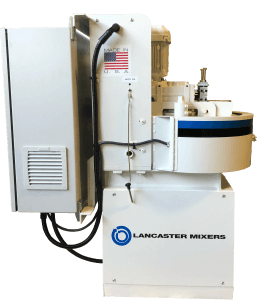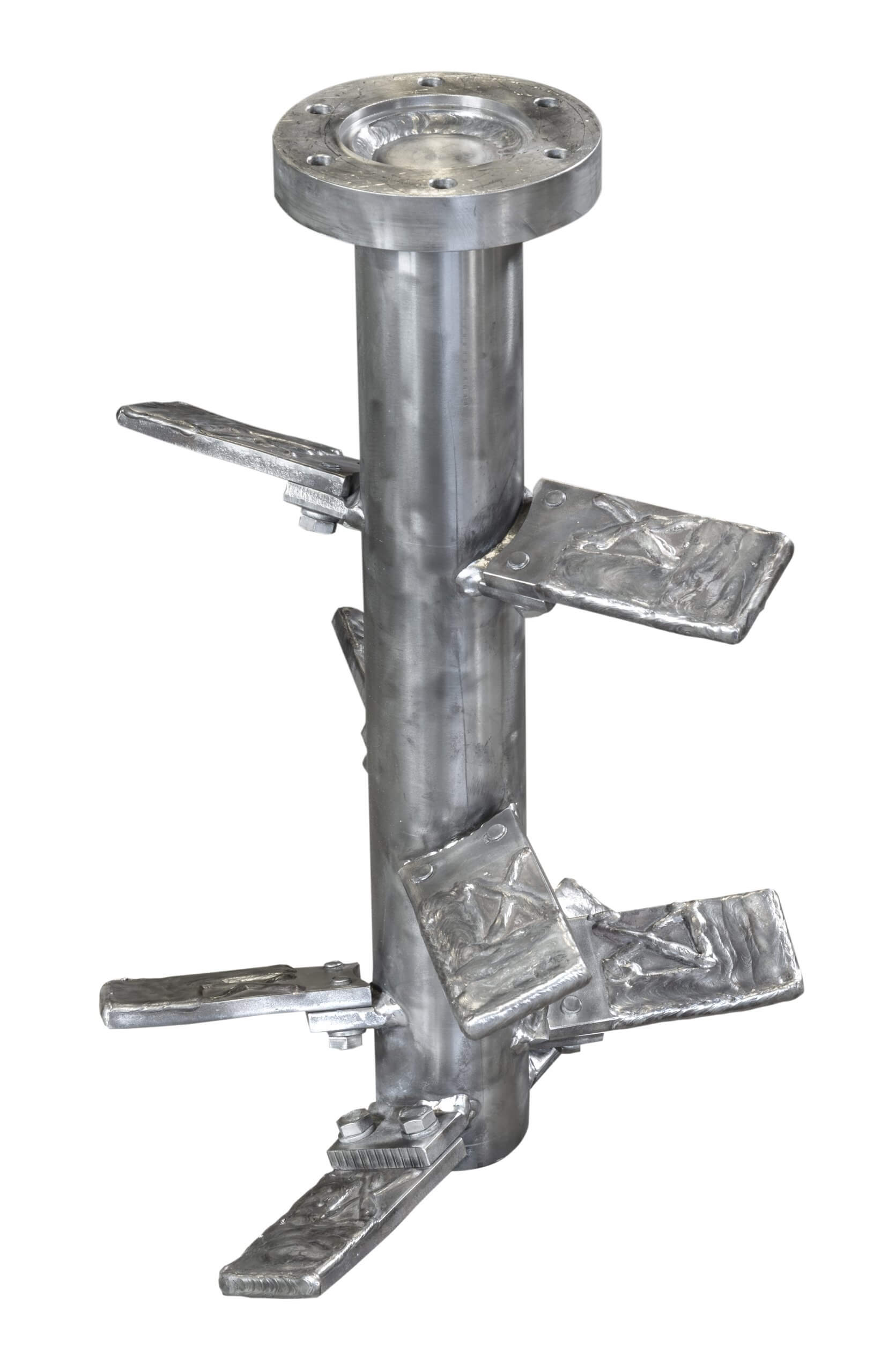Blog-News
Maintenance Bulletin: Rotor Wear and Replacement in Industrial Mixers
The high-speed rotor is the primary mixing and pelletizing tool in industrial high shear mixers and in many ways, it is the most utilized part of the machine. But rotor wear is also a good leading indicator of your machine’s overall operating condition as it is a direct result of material processing. Chances are, if the rotor is worn, there is other preventative maintenance to be done.

What Preventative Maintenance Will Prolong the Life of My Mixing Equipment?
Industrial mixers are built to run and withstand a great deal of abuse, however, regular preventive maintenance efforts can help keep your mixer running like new. The two most critical components that can affect the life of your mixer are lubrication and inspection of working tools. Below is an overview of the in-depth information provided in our full maintenance schedule available for download below.
![]() Lubrication: Proper lubrication can encompass multiple areas on your mixer, not just the shaft seals of the mixing tool. Lubrication of all seals as well as drive gears, discharge valves and other locations where bearings are utilized is the best way to extend the life of your mixer. Automated lubrication systems on larger production mixers help maintain proper lubrication intervals, but regular visual inspection should be scheduled to assure the system is working properly.
Lubrication: Proper lubrication can encompass multiple areas on your mixer, not just the shaft seals of the mixing tool. Lubrication of all seals as well as drive gears, discharge valves and other locations where bearings are utilized is the best way to extend the life of your mixer. Automated lubrication systems on larger production mixers help maintain proper lubrication intervals, but regular visual inspection should be scheduled to assure the system is working properly.
Mix-Granulating with a Lancaster K-Series High Shear Mixer
Many reasons compel industrial operations to enlarge solid particles for handling. Some objectives may be: enhancing flow properties, recycling, de-dusting, densifying, freezing ingredient distribution, improving mold filling properties, etc. Size–Enlargement in the powder technology context include: agglomerating, pelletizing, granulating and briquetting. This article deals with particle enlargement generally through a snowballing mechanism, with some shear action, but without the application of high pressure or extrusion.
Most powders having the ability to fuse, or slightly dissolve in the presence of a liquid, can be granulated quite easily. Others may be coaxed to form granules by the introduction of some suitable binders. The binders may act as a medium for the solid particles to adhere to each other by modifying interfacial activities. Some may form a matrix to capture the particles. Others may involve chemical reactions to achieve the objective.
Synergies Between Lancaster Products, Bradley Pulverizer, and Kercher Industries Lead to Improved Efficiencies and Market Growth
In January of 2020, Lancaster Products/Kercher Enterprises owner, Curt Snyder, acquired the assets of Bradley Pulverizer and we are thrilled to add over 130 more years of complementary industry experience to our 70+ years. While each will continue to operate as 3 separate businesses, we are already leveraging the benefits of the new acquisition. When Snyder first explored this opportunity he immediately identified 5 primary synergies between the businesses that would benefit from cross-company collaboration and improve efficiencies to benefit our organizations as well as our combined pool of clients.
In just a short amount of time a strategic plan has been instituted to align the best of all 3 companies with a focus on the following:
Benefits of High Shear Mixing in Ferrite Processing
Ferrite materials have a dark grey to black color, possess strong magnetic properties and are categorized into ‘Hard’ and ‘Soft’ sub-classes. They are actually classified as ceramics due to their composition being a combination of metallic oxides. Hard ferrites have strong coercivity, showing relatively permanent magnetic properties. Soft ferrites have low coercivity, hence their magnetization can switch direction without much energy requirement or heat generation. This characteristic can be very useful. For this reason soft ferrites find wide applications in electronic industries.
Ferrites are generally synthesized using an iron oxide based powder through a solid phase reaction incorporating other metals, such as magnesium, zinc, manganese, nickel, cobalt etc. to achieve various desired properties. One critical requirement in the synthesis is a high degree of mix homogeneity which impacts on microscopic composition, consequently product quality. Typical processing sequence in the manufacture of ferrite products are: mix powders–>freeze recipe (by granulation)–>dry–>calcine–>mill–>spray-dry–>form and sinter to achieve the desired magnetic properties (see figure below). Calcination at sub-sintering temperatures (800°C – 1100°C) is considered beneficial in pre-consolidating metals for subsequent sintering which occurs generally between 1200°C – 1400°C. Calcination also eliminates carbonates.

Case Study – High Shear Mixing of Clay Compositions
 High Shear mixers are used in a wide variety of applications in many different industries. Finding the right blend and being able to produce the same mix consistently is the key to success at Highwater Clays, a clay and glaze supplier to the arts & crafts industry. The company has two locations with the main production center located in Ashville, North Carolina. Highwater Clays produces a wide range of clay bodies using fireclays, ball clays, kaolin, and stoneware clays. All the clay bodies consist of complex compositions and must be mixed into one reliable consistency.
High Shear mixers are used in a wide variety of applications in many different industries. Finding the right blend and being able to produce the same mix consistently is the key to success at Highwater Clays, a clay and glaze supplier to the arts & crafts industry. The company has two locations with the main production center located in Ashville, North Carolina. Highwater Clays produces a wide range of clay bodies using fireclays, ball clays, kaolin, and stoneware clays. All the clay bodies consist of complex compositions and must be mixed into one reliable consistency.
Lancaster Products Announces Updates to Low Shear Mixers
 We are excited to announce several recent improvements to the design of our low shear mixer product line. These mixers are often pushed beyond the limits of other mixers due to their widespread use in mixing dusty, abrasive, corrosive, highly viscous or explosive materials. The enhancements listed below were designed to improve the performance of our low shear mixers and to minimize maintenance and repair costs, which lowers the overall lifetime cost of ownership for our clients.
We are excited to announce several recent improvements to the design of our low shear mixer product line. These mixers are often pushed beyond the limits of other mixers due to their widespread use in mixing dusty, abrasive, corrosive, highly viscous or explosive materials. The enhancements listed below were designed to improve the performance of our low shear mixers and to minimize maintenance and repair costs, which lowers the overall lifetime cost of ownership for our clients.
- Split drivetrain: pan and tooling on separate drives
The counter-rotating pan and tooling are now operating on separate drives allowing for individual control of tool and pan speeds. This simple split drive design provides increased flexibility to customize mixing recipes for different materials as compared to a single vertical shaft. Maintenance and trouble- shooting of issues relating to the pan or tooling also become easier.
Press Release: Bradley Pulverizer Acquired By Lancaster Products Owner
BRADLEY PULVERIZER ACQUIRED BY LANCASTER PRODUCTS OWNER
Allentown, Pennsylvania, January 17th, 2020 – Bradley Pulverizer is pleased to announce new ownership. Lancaster Products & Kercher Enterprises’ owner Curt Snyder acquired the assets of Bradley Pulverizer through an affiliate effective on January 14th, 2020. Bradley Pulverizer specializes in the design, manufacture, and supply of pulverizing systems for fine and semi-fine grinding of hard, friable, abrasive materials for various applications throughout the world.
The Effect of Rotor Styles on High Shear Mixing
 In addition to the rotating pan, all high shear mixers manufactured by Lancaster Products larger than a K3.5 have two independently motor driven mixing tools inside the pan which are responsible for proper mixing, pelletizing, and granulating of materials: the plow and the high speed rotor. The plow continually sweeps the entire surface of the pan bottom to prevent material from accumulating on the bottom and enhances the overall mixing action. However, the most important tool of all is the high-speed rotor, which rotates counter direction to the pan causing a shearing action inside of the mixing cavity. This high-speed rotor not only agitates the mixture, but significantly influences the control of the entire process. While there are just two main style of standard rotors, we can custom configure the rotor to optimize all mixing processes.
In addition to the rotating pan, all high shear mixers manufactured by Lancaster Products larger than a K3.5 have two independently motor driven mixing tools inside the pan which are responsible for proper mixing, pelletizing, and granulating of materials: the plow and the high speed rotor. The plow continually sweeps the entire surface of the pan bottom to prevent material from accumulating on the bottom and enhances the overall mixing action. However, the most important tool of all is the high-speed rotor, which rotates counter direction to the pan causing a shearing action inside of the mixing cavity. This high-speed rotor not only agitates the mixture, but significantly influences the control of the entire process. While there are just two main style of standard rotors, we can custom configure the rotor to optimize all mixing processes.
Infographic: Optimize Your Fertilizer Pelletizing Process
Traditional processes for manufacturing fertilizer require many steps and different types of equipment. It is common for systems to include multiple dryers, a mill/pulverizer for size reduction of dried material, pin mixer/pug mill for mixing of additives and raw materials, a pelletizer and multiple conveyors to facilitate the process. If this seems like a complex process that requires high levels of work, energy and maintenance, we agree.
Lancaster Products engineers can optimize existing complex fertilizer pelleting processes or design new streamlined systems to help you realize multiple benefits, including a reduction in physical footprint and an improvement in the characteristics and reproducibility of your pelletized product. By utilizing a Lancaster Products K-Series High Shear Mixer to replace a mill and disc pelletizer, you not only reduce system complexity but also gain the ability to begin processing with raw materials at higher moisture levels. The counter-current mixing action in a Lancaster Mixer allows for one-step mixing and pelletizing with rapid mix times.





